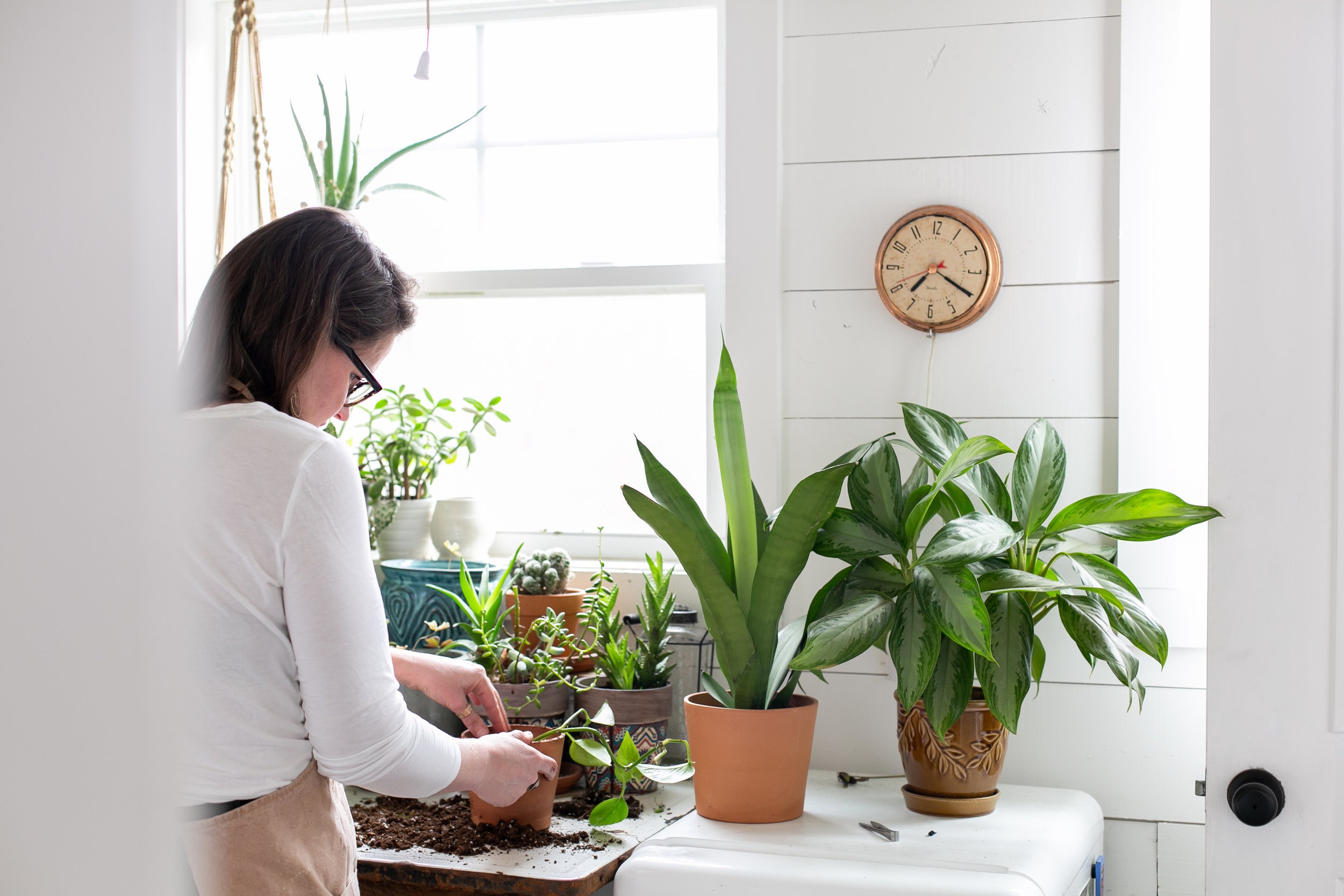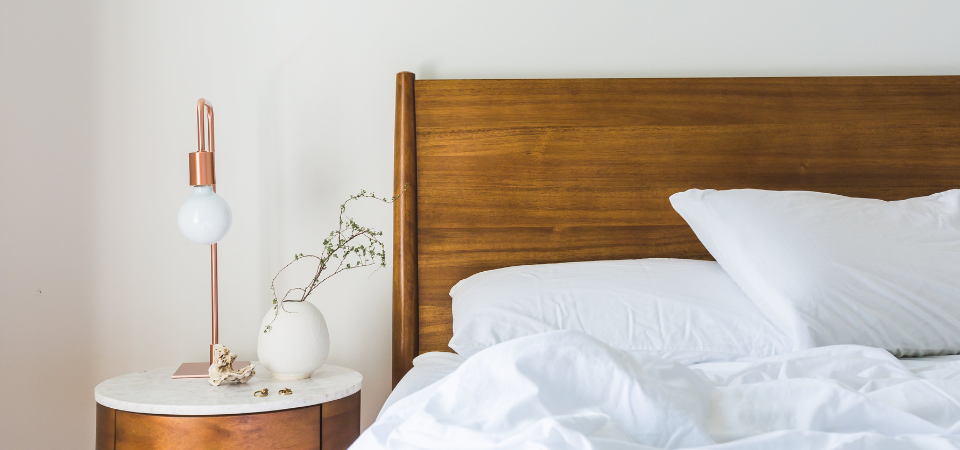“For me, cultivating a houseplant haven is my go-to for designing spaces, but it’s also my favorite form of self-care.” ~Laura Vien
Have you ever considered the importance of nature on your well-being? What about the benefits of a single plant? Besides beautiful design elements in our homes and offices, have you ever thought about houseplants reducing your stress? For me, cultivating a houseplant haven is my go-to for designing spaces, but it’s also my favorite form of self-care.
Since having my daughter and working full time, making time for the gym or a hot yoga class, which used to be my outlet for stress relief, has become a challenge. While houseplants won’t necessarily raise my heart rate and burn calories, they do aid in my psychological health and boost my creativity, allowing me to relax, mediate, and disconnect from the noise.
As military spouses, our lifestyles are often affected by chronic stress which can leave us unmotivated, uninspired, and even depressed. So, where do you start with using plants to mitigate that stress? Here are a few fail-proof plants that have helped me cope with everyday challenges as well as make a happy and healthy home.
SANSEVIERIA
The Snake Plant is a great beginner plant! They love bright, indirect light but tolerate low-light interiors. Less is more with these guys and despite what you’ve heard, you can kill them if you overwater. Other than that, they are hardy and thrive on neglect.
Health Benefit: Emit oxygen at night allowing for a better night’s sleep. Great for bedrooms.
How I Benefit: Divide and conquer. Propagating sansevieria is easy and for me it releases happy hormones. Either by taking a leaf cutting or through division, being immersed in this activity allows levels of serotonin and dopamine to rise (similar to exercising), which results in lowering cortisol levels, the hormone associated with stress.
Design Tip: Their long vertical stems add a striking design impact and look great on a stairwell landing or in a neglected corner. They can easily move between the indoors and outdoors and look amazing alone or potted with other plants.
Care Tip: Treat just like any other succulent—water sparingly. Sanseviervia’s thick leaves hold water so they are drought tolerant. Allow soil to dry out between watering. I water them like my cacti, once or twice a month, depending on how much light they are receiving.
PHILODENDRON
These statement plants look great hanging from the ceiling or climbing up a wall. They even thrive when you forget to water. They are low-maintenance plants that add a beautiful leafy backdrop to any location.
Health Benefit: Another plant that improves air quality and on NASA’s top 10 list for removing harmful toxins.
How I Benefit: I love wiping down my philodendron’s glossy shiny leaves. This is relaxing for me and allows me to connect with the plant, something beneficial for me and the plant. While wiping down the leaves, I’m not worrying about the future but instead focusing on the present, admiring the shape, the color, and every detail of the plant.
Design Tip: A vining philodendron can benefit from a trellis or moss pole, perfect for vertical dimensions and conversation pieces. My personal favorite is ‘Lemon Lime’ philodendron hederaceum. The bright leaves add a pop of color to any interior.
Care Tip: Allow the top inch of soil to dry out between watering. They love sunny spots but not direct sun on their leaves. Pay attention to their signals. If leaves turn yellow, it’s probably getting too much sun. If stems are getting lengthy with space between leaves, the plant is stretching to get to more light.
POTHOS
The forgiving plant that looks perfect sitting high on a shelf or trailing in a hanging planter. Pothos don’t demand a ton of attention, which is ideal for busy people or the ones that claim to have a black thumb.
Health Benefit: Remove formaldehyde benzene and carbon monoxide from the air while also helping eliminate odors like a previous tenant’s pet smell or cigarette smoke.
How I Benefit: Improve my mental fatigue at work caused from computers and lighting. Having a pothos on your desk that you can simply glance at it, according to research, boosts moods, combats depression, and generates opportunities for cognitive restoration, something we can all benefit from.
Design Tip: There are so many varieties and come in an array of green hues. My personal favorites include scindapsus pictus ‘Exotica’ and a ‘Neon Pothos’, epipremnum aureum.
Care: Pothos can get leggy. Prune to control shape. Pay attention to their leaves. Loss of variegation means too little sun. Pale leaves may mean too much sun. When leaves droop it’s time for a drink. Let soil dry out between watering.
ALOE VERA
The striking easy-to-grow succulent purifies the air but also provides great medical value. They can stay rather small which is ideal if your home is lacking space.
Health Benefit: The gel and the juice from aloe vera are used in many health products today. From pain relief of minor cuts and acne, to supporting thyroid and intestinal health, aloe vera is a great natural healer. The juice can boost immunity and soothe the digestive tract. Be sure to consult with your doctor before you ingest any of your aloe vera’s juices.
How I Benefit: Aloe vera emits oxygen at night, creating purer quality air. I use the gel inside to treat sunburns and psoriasis on my scalp. I add the gel to my shampoo which strengthens and heals my scalp with just a few washes.
Design tip: I keep mine in our guest bedroom to provide our guest with a better night’s sleep.
Care: Loves a sunny spot like a kitchen windowsill, a perfect place to have a handy natural first aid remedy. With its shallow roots, aloes enjoy wider pots rather than deeper. Mine enjoy terracotta planters since they dry out quickly.
While these are only a few plants that you can benefit from, there are many that come in many shapes, sizes, and varieties, so choose the one that speaks to you. Plants will bring new life into your home and will support your happiness and good health. If houseplants are not possible for you to own, consider other methods with engaging with the natural environment. Nature walks, forest bathing, or simply stepping outside to breathe are all effective ways to improve our well-being. Staying close to nature, observing all the little and significant elements of it, will allow you to leave some stress behind and self-heal during the process.
The Health Benefits of Indoor Plants ~Laura Vien
ABOUT LAURA
Laura is a creative, environmental consultant, plant novice and storyteller. She resides in her jungle with her husband, daughter, and precious pup, Bonnie Blue. Most days you can find her admiring her plants, styling beautiful spaces, or hiking with her family. Her work was featured in Volume IV of Legacy Magazine in which she shares how creating a beautiful environment with plants has both design flare and health benefits. Much like her plants, Laura thrives where she can build off the energy around her.
CONNECT WITH LAURA
Originally published 6/4/19













